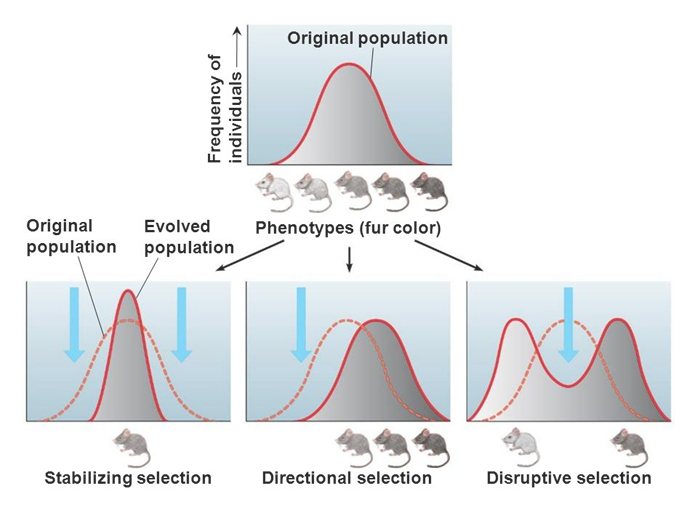Sponsor Area
Theories And Mechanism Of Evolution
(a) Name and define the three types of natural selection.
(b) State the following:
(i) Hardy Weinberg’s principle
(ii) Theory of recapitulation
a.
Three types of natural selection:
(i) Directional Selection: Any one phenotype produces a regular change in a gene pool of a population in one direction with respect to one or some specific characteristics-Progressive.
(ii) Disruptive or diversifying selection: The selection breaks up a previously homogenous population into several different adaptive norms. It simultaneously favours individuals at both extremes of the distribution curve/eliminates intermediate types/ population represented by both extreme phenotypes.
(iii) Stabilizing Selection: Favours average or normal phenotypes and eliminates variants or new mutation. It favours homozygosity and mostly intermediate. Acts as a Balancing selection and favours phenotypic features of organism coincide with optimal environmental conditions or one which is best adapted.
b. (i) Hardy Weinberg’s Principle: States that the allele and genotype frequencies in a population will remain constant from generation to generation in the absence of other evolutionary factors or sources/Mathematical Expression (p2 + 2pq + q2 = 1).
(ii) Theory of Recapitulation: Ontogeny (embryonic development of an organism) recapitulates phylogeny of their ancestors in an abbreviated form. / Embryos in their development repeat the evolutionary history of their ancestors.
Who was the originator of the theory of Natural Selection ? Explain the evolution of species by this theory.
Theory of Natural selection was given by Charles Darwin and Alfred Russel Wallace.
Theory of Natural selection is based on the following points :
1. Overproduction : All living beings have an inherent tendency to produce offspring of their own kind in large number for the perpetuation of their race. This is called geometric increase. The number of their offspring is much more than can be supported by a particular environment and can possibly survive.
2. Limited Space and Food : The space in the universe remains constant. The ultimate source of food for plants and animals also remain constant. Therefore, the carrying capacity of the environment does not allow the population to grow indefinitely. Therefore, in spite of enormous reproductive potential of living beings under natural conditions the number of individuals of each species remains nearly constant over a long period of time.
3. Struggle for Existence : According to Darwin, individuals multiply in geometric ratio whereas space and food availability remains constant, so there is an intense competition and three fold struggle for existence. The struggle is intraspecific (between individuals of the same species), interspecific (between individuals of the different species), struggle (between living beings and changes of environment such as heat, cold flood, etc.)
4. Variations : The offsprings are similar to parents, but not identical i.e., they show some changes in shape, size, colour i.e. variations. No two individuals are identical except the identical or homozygotic twins. The everlasting competition among the organisms has compelled them to change in accordance with the conditions to utilize the natural resources and survive successfully.
5. Natural Selection and Survival of the Fittest : Darwin believed that as in artificial selection, man selects animals or plants with desired character, in the same way nature selects only those individuals which are with more favourable variations and are best adapted to the environment. The less fit and unfit organisms are left out by selection. This sorting out of individuals with useful variations is called Natural Selection by Darwin. Individuals with favourable variations survive reach adulthood and reproduce offsprings, others fail to do so. This is called differential reproduction. Darwin has called this differential reproduction as natural selection
6. Inheritance of Useful Variations : Individuals which survive the struggle for existence transmit their useful variations to the offsprings, which will also prove to be fit. Thus offsprings of selected individual are born fit to the environment.
7. Formation of New Species : According to Darwin new variations appear in energy generation and supplement the favourable variations inherited from parents. Thus, variations keep on accumulating and after a number of generations, the offsprings become markedly different forming a new species.
Write the causative agent and the most important symptom of each of the following diseases :
(i) Whooping cough
(ii) Tuberculosis
(iii) Measles
(iv) Malaria
(i) Whooping cough :
Causative Agent : Bacterium, Bordetella pertusis.
Symptom : Severe coughing with characteristic gasping whoop and vomiting.
(ii) Tuberculosis :
Causative Agent : Bacterium, Mycobacterium tuberculosis.
Symptom : Fever, general weakness, loss of appetite, persistent coughing with yellowish and blood stained sputum.
(iii) Measles :
Causative Agent : Rubella virus.
Symptom : Common cold, headache, fever, cough, inflammation of mucous membrane of nasal and buccopharyngeal region, skin eruption as small red spots.
(iv) Malaria :
Causative Agent: Plasmodium
Symptom : High fever (upto 105-106°F) with shaking chill, severe headache and nausea.
What are the important changes in the evolution of the modern horse from the Eohippus (ancestral horse) ?
In the evolution of horse, following evolutionary changes occurred :
(1) Progressive Evolutionary Trends
(i) General increase in size and weight.
(ii) Lengthening of limbs.
(iii) Lengthening of middle toe in both fore limbs and hindlimbs.
(iv) Increase in height.
(v) Increase in neck length.
(vi) Enlargement and complexity of brain, specially cerebral hemispheres.
(vii) Lengthening of facial region of head.
(viii) Increase in the complexity of molar teeth.
(2) Progressive Evolutionary Trends
(i) Progressive loss of toes in both forelimbs and hindlimbs.
(ii) Progressive loss of canines in both upper and lower jaws.
(iii) Loss of hair from the body.
Sponsor Area
Mock Test Series
Mock Test Series





